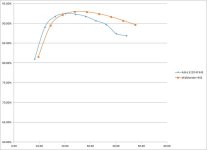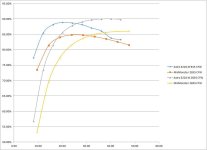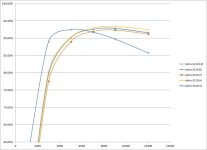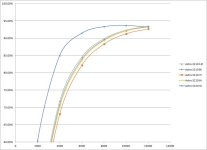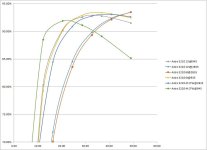Greetings motor experimenters,
I need to find a new motor for my electrathon racer. The old one was damaged by overheating and, despite valiant effort, a professional rewind shop could not get the same amount of wires back in.
Electrathon racing is one of the most fun, inexpensive, open engineering forms of racing. While the speeds tend to be low, 25-30 MPH on tight twisty parking lot tracks, the combination of close racing, low grip tires and instant torque make for exciting challenging driving.
Most races are an hour long and pack capacity is limited to 1000 Watt hours. Vehicle design is very open. Basically more then two wheels and a driver balasted to 180 pounds. More about electrathon racing here: http://www.electrathonamerica.org/Welcome_to_Electrathon_America.html
An in car video from my car: http://proev.com/PEVvids/2015/usf2015_2.htm
For any electric racing vehicle who's battery pack capacity is optimised for it's series (meaning that the vehicle only carries enough batteries to finish the race), motor efficiency is normally of greater importance than motor torque or power.
To rephrase this, to be fast, it is generally more important to get the most work out of the stored energy than peak torque or power.
Back to this specific case. I am running Kokam lithium polymer cells. 16 in series, each rated for 16 amp hours. This works out to 59.2 nominal voltage and a tested capacity of 947 Watt hours at the 1C discharge rate.
Since the races are 1 hour long, the motor should see an average of around 947 Watts (assuming I do my job correctly).
The way to get the most energy out of the battery pack is to ran a current of 16 amps the whole race. This is because Puekert's exponent is an exponent. The faster I discharge the battery, the exponentially less total energy the battery will be able to deliver. For the Kokam High Energy type cells the change in pack capacity is small, 98%@ 2C, 97% @3C, but 78%@5C.
So, ideally, all I need is the best 947 Watt continuous rated motor around. Except real world, I cannot run a constant current of 16 amps. I need to lift (and regen) for the tighter corners which means I can use more power the rest of the time. It is also useful to have extra power when dicing with another car. We also occasionally blow a tire or lose a chain and then need to run higher amps to make up for time lost in the pits.
The other factor is that the motor controller combination is more efficient at full throttle than at partial throttle. So the best driving technicque seems to be full throttle coming out of the corner and then lift and coast until the next corner.
My clearest testing of this method is with the Adaptto Max-e controller and my old motor on an oval track where lifting for the corner was not required.
First I tried setting an 16 amp limit in the controller. Lap times were 20% slower using the same power, than when I moved my amp limit to 60 amps and use full throttle and lift and coast.
I also tried setting a constant speed in the controller. This method used 11% more power to go the same speed than I could achieve with the list and coast method.
It is possible that these differences are due to something funky in how Adaptto limits speed or max current but I also found that my best lift and coast lap at the 30 amp limit was 1.4% slower and used 1.8% more power than when I set the limit at 60 amps.
My conclusion is that current limit and speed limit methods basically set the controller to a constant partial throttle that was less efficient than the higher power setting. Running lift and coast at 60 amps is greater 'on' time then 30 amps and also slightly more efficient.
My last motor was capable of 12,000 Watts peak. Ideally, I think I would like a motor that can do 2,000 Watts continuously and 8,000 Watts peak (8C is the limit of the pulse discharge of the cells).
I am planning on using a Grin BAC2000 Controller or an Adaptto Max-e.
I have read that the ideal hub motor is always going to be less efficient than the ideal mid drive. Is that true?
I am running 16" wheels which limits my choices in hub motors as well. My current set up is a middrive using a #35 chain and go kart gears. This allows me a fair amount of flexibility to adjust the motor RPM. I carefully adjust and lube the chain so I hope this only costs 1-2% energy loss.
So to sum things up, I need a motor that can do 2,000 Watts continuously and between 5,000 and 8,000 peak. It should be as efficient as possible with a fairly broad efficiency curve. It needs to be able to do regenerative braking. The lighter the motor, the better.
Suggestions?
I need to find a new motor for my electrathon racer. The old one was damaged by overheating and, despite valiant effort, a professional rewind shop could not get the same amount of wires back in.
Electrathon racing is one of the most fun, inexpensive, open engineering forms of racing. While the speeds tend to be low, 25-30 MPH on tight twisty parking lot tracks, the combination of close racing, low grip tires and instant torque make for exciting challenging driving.
Most races are an hour long and pack capacity is limited to 1000 Watt hours. Vehicle design is very open. Basically more then two wheels and a driver balasted to 180 pounds. More about electrathon racing here: http://www.electrathonamerica.org/Welcome_to_Electrathon_America.html
An in car video from my car: http://proev.com/PEVvids/2015/usf2015_2.htm
For any electric racing vehicle who's battery pack capacity is optimised for it's series (meaning that the vehicle only carries enough batteries to finish the race), motor efficiency is normally of greater importance than motor torque or power.
To rephrase this, to be fast, it is generally more important to get the most work out of the stored energy than peak torque or power.
Back to this specific case. I am running Kokam lithium polymer cells. 16 in series, each rated for 16 amp hours. This works out to 59.2 nominal voltage and a tested capacity of 947 Watt hours at the 1C discharge rate.
Since the races are 1 hour long, the motor should see an average of around 947 Watts (assuming I do my job correctly).
The way to get the most energy out of the battery pack is to ran a current of 16 amps the whole race. This is because Puekert's exponent is an exponent. The faster I discharge the battery, the exponentially less total energy the battery will be able to deliver. For the Kokam High Energy type cells the change in pack capacity is small, 98%@ 2C, 97% @3C, but 78%@5C.
So, ideally, all I need is the best 947 Watt continuous rated motor around. Except real world, I cannot run a constant current of 16 amps. I need to lift (and regen) for the tighter corners which means I can use more power the rest of the time. It is also useful to have extra power when dicing with another car. We also occasionally blow a tire or lose a chain and then need to run higher amps to make up for time lost in the pits.
The other factor is that the motor controller combination is more efficient at full throttle than at partial throttle. So the best driving technicque seems to be full throttle coming out of the corner and then lift and coast until the next corner.
My clearest testing of this method is with the Adaptto Max-e controller and my old motor on an oval track where lifting for the corner was not required.
First I tried setting an 16 amp limit in the controller. Lap times were 20% slower using the same power, than when I moved my amp limit to 60 amps and use full throttle and lift and coast.
I also tried setting a constant speed in the controller. This method used 11% more power to go the same speed than I could achieve with the list and coast method.
It is possible that these differences are due to something funky in how Adaptto limits speed or max current but I also found that my best lift and coast lap at the 30 amp limit was 1.4% slower and used 1.8% more power than when I set the limit at 60 amps.
My conclusion is that current limit and speed limit methods basically set the controller to a constant partial throttle that was less efficient than the higher power setting. Running lift and coast at 60 amps is greater 'on' time then 30 amps and also slightly more efficient.
My last motor was capable of 12,000 Watts peak. Ideally, I think I would like a motor that can do 2,000 Watts continuously and 8,000 Watts peak (8C is the limit of the pulse discharge of the cells).
I am planning on using a Grin BAC2000 Controller or an Adaptto Max-e.
I have read that the ideal hub motor is always going to be less efficient than the ideal mid drive. Is that true?
I am running 16" wheels which limits my choices in hub motors as well. My current set up is a middrive using a #35 chain and go kart gears. This allows me a fair amount of flexibility to adjust the motor RPM. I carefully adjust and lube the chain so I hope this only costs 1-2% energy loss.
So to sum things up, I need a motor that can do 2,000 Watts continuously and between 5,000 and 8,000 peak. It should be as efficient as possible with a fairly broad efficiency curve. It needs to be able to do regenerative braking. The lighter the motor, the better.
Suggestions?


